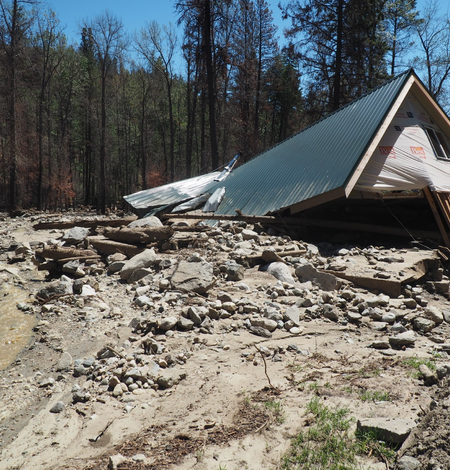USGS Firelight: PHIRE Edition - Vol. 2 | Issue 2
Welcome to the special Post-Fire Hazards Impacts to Resources and Ecosystems (PHIRE) issue of Firelight! The PHIRE project provides science to characterize climate-amplified, uncharacteristic patterns of wildfire disturbance and post-fire ecosystem recovery and enhance prediction of environmental impacts and post-fire hazards.
Improving Postfire Debris-Flow Hazard Assessments In The Pacific Northwest Through Application Of Debris-Flow Models
As part of the Post-fire Hazards and Impacts to Resources and Ecosystems (PHIRE): Support for Response, Recovery, and Mitigation Project, the PHIRE Debris Flow Hazard team is engaging in several studies to better understand the spatial and temporal drivers of postfire debris flows and improve postfire hazard assessments across northern California and the Pacific Northwest.
Identifying Chains of Consequences and Interventions for Post-fire Hazards and Impacts to Resources and Ecosystems
As part of a broader USGS project on Post-fire Hazards and Impacts to Resources and Ecosystems (PHIRE): Support for Response, Recovery, and Mitigation, the PHIRE social science team convenes stakeholders involved in post-fire hazard science and decision-making to identify potential consequences resulting from post-fire hazard scenarios along with strategies to reduce the likelihood or severity of...
Post-wildfire sedimentation and release of metals to Conconully Reservoir, Washington
Wildfires can negatively impact reservoirs and water supply. In 2021, a wildfire in Okanagan County, Washington, engulfed a large area around Conconully Reservoir. USGS scientists are assessing sediment and water quality in the reservoir and surrounding streams.
Post-Fire Hazards Impacts to Resources and Ecosystems (PHIRE)
Support for Response, Recovery, and Mitigation
Post-Fire Sediment Research at the Pacific Coastal and Marine Science Center
The USGS Pacific Coastal and Marine Science Center (PCMSC) in Santa Cruz, California, has been growing our post-fire research contributions since 2017, through studies of post-fire sediment movement that address the Natural Hazards Mission Area objectives for understanding wildfire hazards.
Characterizing Post-Fire Burn Severity And Vegetation Recovery At High Spatial And Temporal Resolutions Using Basal Area Measurements
USGS scientists are studying the effects of wildfires on forests and developing models to predict forest recovery potential after fires. They have collected and analyzed data from several recent California wildfires, including the Dixie, Caldor, KNP Complex, Carr, and Mosquito fires. Researchers are using the data to analyze changes in basal area (the cross-sectional area of tree trunks) to...
Evaluating Cultural Resource Vulnerability To Fires And Post-Fire Impacts
Cultural resources are tangible and intangible elements connected to the physical presence, practices, cultural identity, and/or spirituality of past and present societies.
Remote Sensing Characterization of Post-Fire Vegetation Recovery
Remote sensing is a powerful tool to measure fire's effects on plant life. How severe was the damage to vegetation? How quickly can a landscape recover? A new project is looking at those questions from a before, during, and after fire perspective, and the Wildland Fire Team at EROS investigates how using different remote sensing technologies together might help.
Advancing Fire Behavior Modeling For Post-Fire Hazards Assessments
Fire behavior is a complex and highly variable process in both space and time. The interdisciplinary PHIRE team includes USGS scientists from across the Mission Areas, research collaborators from universities and federal agencies, and federal, state, and tribal practitioners and stakeholders.
Webinar Series - Fueling Discovery with USGS Wildland Fire Science
Fueling Discovery with USGS Wildland Fire Science is a public webinar series hosted by USGS Wildland Fire Science and the Ecosystems Mission Area. These webinars are meant to provide information on the breadth of USGS fire science used by stakeholders to make decisions before, during, and after wildfires in ecosystems across the U.S.









